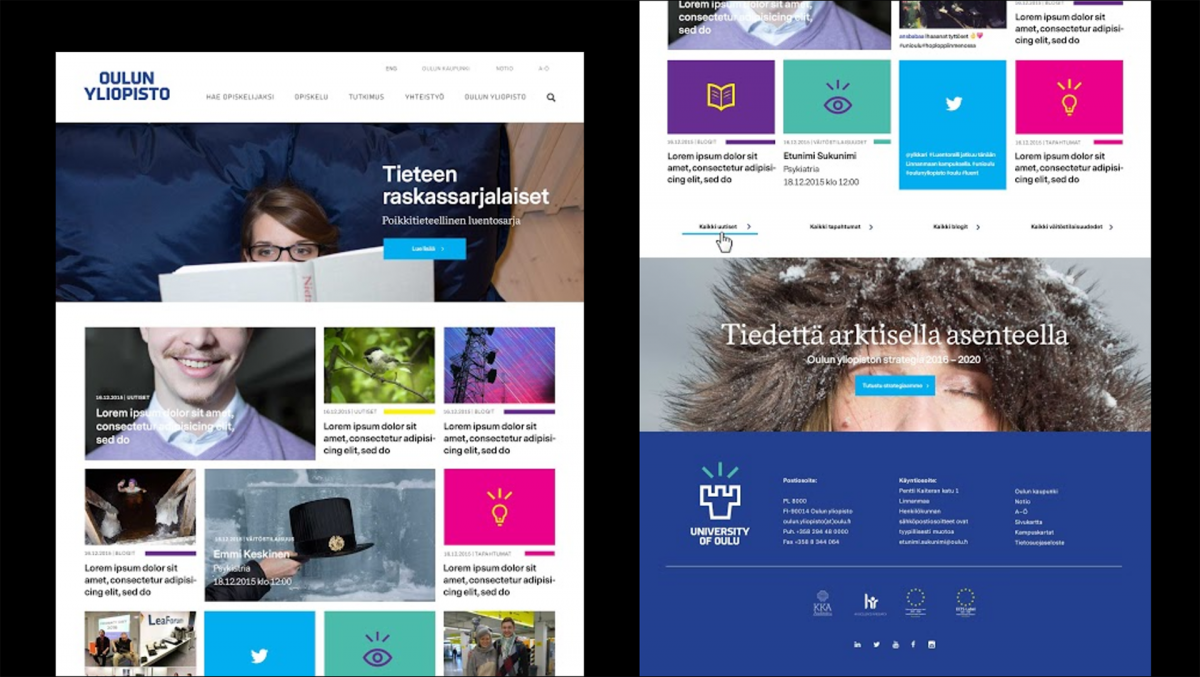Holistic design of a digital presence
To transform the University of Oulu website, we put our full range of user research, concept, product and visual design skills to use. Our designers and technical experts worked together with the University’s representatives to create the best solution for them, all based on end-user knowledge. Our close collaboration and the iterative, holistic design approach also allowed us to respond to any issues and modification needs immediately, keeping the project on track and moving swiftly.

Gaining user insights
The main focus of our work is always the end user, and we strive to create practically viable, need-based solutions that users can fall in love with. To achieve this in a complex development process, it is easier and far less time consuming to lay the groundwork carefully, making the necessary modifications before moving on to the actual execution. This is why we kickstarted the project with an intensive research week at the University’s campus, involving all stakeholder groups in the design process using several tools:
- Target group interviews
- Observing campus life
- Daily “Innovation Hour” workshops, open to everyone
- Rapid prototyping and user testing
- User persona and customer journey workshops
Involving the end users from the beginning helped us to understand their needs and incorporate them into the next stages. Both our experts and the university’s representatives had a say in creating next steps for the project.

Ideation and co-creation
After gathering data from all available sources such as internal and external stakeholders, we documented and outlined the collected data and analysed the findings. We created stakeholder journeys, personas and prioritised the data points to feed the ideation and co-creation process.
In the ideation phase we facilitated a series of workshops with the key stakeholders. We used different service design and design thinking methods to establish an efficient and iterative process while taking into account the different voices of the many stakeholders.
Testing the ideas
During our iteration process, we created both analog and digital rapid prototypes to test the different ideas and hypotheses and also to communicate the new user experience and also the new look and feel of the new digital service design.
The final prototypes were then used as the basis for technical implementation. This saved us a lot of time and effort in the implementation phase.
From ideas to reality
After a successful design phase, we were ready to start the technical implementation.
The challenge we faced was that the university has over 200 websites, thousands of content creators and tens of thousands of pages of content. We needed to avoid the situation where simultaneous manual update of 200 websites would be necessary. So we needed to design a solution where the new site would be rolled out smartly and in stages.
We designed a technical process where we could launch the new site in controlled phases. This allowed us to introduce the new look and feel as quickly as possible while also buying us time to fine-tune the solution before launching it for all the 200 websites and thousands of content creators.

Results
The new website was launched in the spring of 2016 and the impact was felt immediately. The University now has a modern, user-centric web presence with a uniform look and feel.
The results have also been quantified, with a 280% increase in front page views, nearly doubled social media traffic and a 10% rise in student applications.
We have also established a data-driven process for further development, where we carefully set targets for activities such as marketing campaigns and then evaluate the results with the help of multiple tools such as online analytics and other sources.

Continuous development
While the new website has exceeded expectations, our work is not yet done. Exove Design continues close co-operation and collaboration with the University. Our experts spend time on-site on weekly basis, helping staff both in content planning and creation and also the design and roll out of new features. The university’s digital presence is continuously developed further, utilising our iterative, data-driven process.
